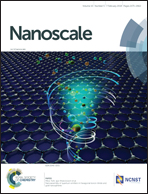pH-Responsible fluorescent carbon nanoparticles for tumor selective theranostics via pH-turn on/off fluorescence and photothermal effect in vivo and in vitro†
Abstract
We developed nanoparticles comprising a photothermal dye (IR825)-loaded carbonized zwitterionic polymer [FNP-I] as “switch-on” pH-responsive fluorescence probes to sense intracellular cancer cells and for near-infrared (NIR) controllable photothermal therapy (PTT) in vivo and in vitro. The fluorescent “off” of FNP-I was activated after reaching the cancer cell environment, where the zwitterionic compartment of FNP lost its hydrophobicity to induce PTT-mediated heat release of IR825 under NIR irradiation in the tumor. Approximately 100% of the IR825 was released from the FNP core to generate high thermal conversion to completely kill the cancer cells. Furthermore, after intravenous treatment of FNP-I into MDAMB-231-cell bearing mice, pH-responsive photothermal therapy was observed, achieving marked ablation of tumor cells with release of IR825 under tumor environment conditions. In addition, fluorescent signals were clearly found at the tumor site after 3 h, decreasing at the 6 h time point. The in vitro and in vivo detection system demonstrated good cellular uptake and biocompatibility as a potential imaging-guided photothermal therapy nanotool for cancer treatment. Interestingly, the synergism of the biosensor and PTT in single FNP-I platform led to more effective cancer cell killing than either monotherapy, providing a new approach for cancer treatment.



 Please wait while we load your content...
Please wait while we load your content...